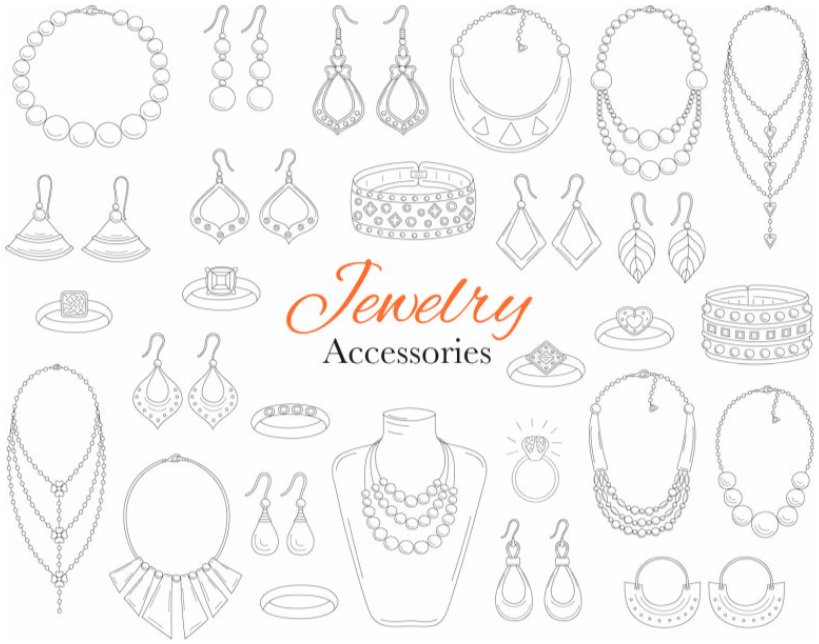History of Jewelry Part Two — Accessories: From Ancient Egypt to the Roaring ‘20s
An outfit isn’t complete without accessories — more specifically, jewelry accessories. Nothing catches the eye more than a complementary necklace or sparkling earrings. Since the beginning of civilization, jewelry accessories have been popular for both men and women — the trend didn’t become more commonly thought of as feminine until the 18th century.
Here, in today’s post —the second entry in our History of Jewelry series — we’re pleased to provide a broad overview of the evolution of jewelry accessories, as well as tell about what’s coming next week, in part three of our series. For Part One in the series, please read History of Jewelry Part One: An Overview.
Early Evidence of Jewelry as an Accessory
Different cultures are known for their own signature jewelry accessories. Ancient Egyptians are often depicted wearing large collar pieces and lapis lazuli stones (a deep blue metamorphic rock that’s prized since antiquity for its intense color), and jewelry adorned with gemstones was first worn by the Romans during the first century.
In Ancient Egypt (from predynastic times to the Greco-Roman period), gold jewelry was a sign of status, with those who were lower class members of society opting for copper. Both men and women in Egypt wore jewelry accessories such as bracelets, earrings, collar pieces, anklets, armbands, and rings, both in life and death. The Egyptians believed that placing amulets on mummies, along with other jewelry pieces, would protect the dead in the afterlife.
Necklaces, Bracelets, and More
Necklaces date back at least 40,000 years to a time when the earliest known articles of jewelry worn around the neck were made from natural elements such as shells, seeds, bird feathers, stones, carved wood, and beads made from teeth and bone. The invention of metalworking around 8,000 BCE added more options to jewelry crafting, such as gold jewelry, which is still quite popular today. The oldest bracelet is thought to be an obsidian piece found in Turkey in 7,500 BC, and bracelets crafted from jade, wood, and gold were highly popular in Ancient China.
Bracelets, like all other jewelry accessories, were once a unisex item, but when the bracelet came back into fashion in the 17th century, it was featured mostly on women. Necklaces also came back into style around that time. The brooch had been the reigning jewelry accessory during the Middle Ages.
Mesopotamia, which today is Southern Iraq, is where archaeologists discovered crescent-shaped gold hoop earrings dating back to about 2,500 BC. Both the Greeks and Etruscans once wore earrings as a symbol of wealth and status, but by the 11th century, elaborate hairstyles and headdresses eclipsed earrings as the statement pieces to frame the face. Not until the late 1500s did earrings became popular again, with another bump in popularity in the 18th century.
Art Nouveau Ushers in a Resurgence in Jewelry Accessories
In the late 1800s, a popular jewelry style emerged called Art Nouveau. Originating in France, it was highly decorative and invoked nature imagery. Most of the Art Nouveau jewelry was made of gold, colored gemstones, and enamel. However, Art Nouveau quickly gave way to the Edwardian style of jewelry, which favored lighter metals such as platinum. Platinum is strong and rigid, so jewelers could carve lacelike filigrees into it. The strength of platinum, along with its non- tarnishing qualities, also made it a popular metal to pair with diamonds. The white tone of platinum also made diamonds look brighter.
Jewelry accessories reached a new height of popularity in the United States in the early 1900s. Those in high society wore their beautiful Edwardian pieces to events, such as the festivities on the ill-fated RMS Titanic ocean liner.
And speaking of the RMS Titanic, here at Shmukler Design, we are very fortunate to know someone who has deep expertise on the jewelry from that time period. Craig A. Lynch, G.G., is the owner of Ouellet & Lynch — an independent gem and jewelry appraisal firm in Phoenix, Arizona. Lynch has been in the jewelry business since 1976 and is a Graduate Gemologist (G.G.) from the Gemological Institute of America. In 2002, he was selected to document and value all of the jewelry recovered from the Titanic.
Next week, in Part Three of our series, Craig will be answering questions about jewelry accessories, including items from the wreckage of the Titanic that he appraised after they were recovered from approximately 12,600 feet below the surface of the North Atlantic Ocean.

